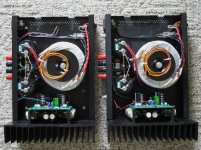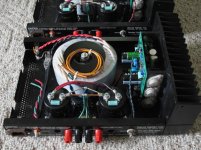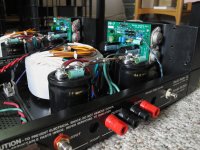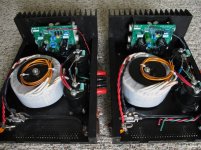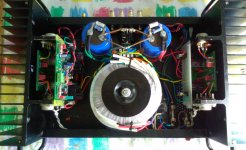Most recent build - MM230 Mundorf MLHC
I have 2 weeks of run time on my 4th set of Musical Concepts PA7 driver boards, these amps were built with the Mundorf MLytic High Current caps... other wise identical to the P230 mono amps built a while back.
The Mundorfs, while pretty expensive ~ ARE REMARKABLE CAPS ~ they sounded superb on / from the first few notes. They have the same type of clarity... along the same lines as the PA7 boards. They have exemplary bass, weight and definition. I would nearly say ~ break-through ~ it is still too early to say definitively... I cannot wait to build another amp or set of amps; with them... My first impressions, are that these amps are more dynamic than the dual mono "Hafler" 500 with PA7 boards and Jensen 4 pole capacitors... a huge feat and statement...
They are everything I had 'expected and hoped for' and even more... I am drawn to say that I like them even better than "my build standard" Nichicon LNT... [which remind me a lot of the Jensen 4-pole caps] the Mundorfs have incredible speed, sense of slam with no overhang and great dynamics, with natural effortless ease, a relaxed, .but not soft. sounding much like the LNTs. I used the 80v / 22,000mfd LNT and am comparing to the *80v / 10,000mfd MLHC... there is no sense of loss in authority, definition or power. The Nichicons were broken in, when I built the other mono amps. I would like to give them a month before making a more clear / concise comment. *80v / 22K MLHC are enormous, would be a huge challenge to squeeze in a(ny) 200 series chassis.
I like these so much playing [these .are. the best sounding amps that I have heard] through my Silverline SR17 Supreme's... I have yet to unplug them (for long enough) to try these amps driving the Maggies, in place of the dual mono, hot-rodded XL600 amp.
**this is over +10th build iteration of my DH200 "ugly duckling" which I only paid 109.00 +tax, shipping on Flea-Bay. It was so rough, heat sinks, were bent and rounded... never have seen anything like it. The allure for me... it did already have Cardas RCAs and the Pomona 5018 5 way binding posts (worth 75-80$) but the driver PC boards had unusable ~150mv DC offset. Sadly, so common... a significant portion to why I ..do not like.. using the stock PC boards, have such great disdain for them.
I have 2 weeks of run time on my 4th set of Musical Concepts PA7 driver boards, these amps were built with the Mundorf MLytic High Current caps... other wise identical to the P230 mono amps built a while back.
The Mundorfs, while pretty expensive ~ ARE REMARKABLE CAPS ~ they sounded superb on / from the first few notes. They have the same type of clarity... along the same lines as the PA7 boards. They have exemplary bass, weight and definition. I would nearly say ~ break-through ~ it is still too early to say definitively... I cannot wait to build another amp or set of amps; with them... My first impressions, are that these amps are more dynamic than the dual mono "Hafler" 500 with PA7 boards and Jensen 4 pole capacitors... a huge feat and statement...
They are everything I had 'expected and hoped for' and even more... I am drawn to say that I like them even better than "my build standard" Nichicon LNT... [which remind me a lot of the Jensen 4-pole caps] the Mundorfs have incredible speed, sense of slam with no overhang and great dynamics, with natural effortless ease, a relaxed, .but not soft. sounding much like the LNTs. I used the 80v / 22,000mfd LNT and am comparing to the *80v / 10,000mfd MLHC... there is no sense of loss in authority, definition or power. The Nichicons were broken in, when I built the other mono amps. I would like to give them a month before making a more clear / concise comment. *80v / 22K MLHC are enormous, would be a huge challenge to squeeze in a(ny) 200 series chassis.
I like these so much playing [these .are. the best sounding amps that I have heard] through my Silverline SR17 Supreme's... I have yet to unplug them (for long enough) to try these amps driving the Maggies, in place of the dual mono, hot-rodded XL600 amp.
**this is over +10th build iteration of my DH200 "ugly duckling" which I only paid 109.00 +tax, shipping on Flea-Bay. It was so rough, heat sinks, were bent and rounded... never have seen anything like it. The allure for me... it did already have Cardas RCAs and the Pomona 5018 5 way binding posts (worth 75-80$) but the driver PC boards had unusable ~150mv DC offset. Sadly, so common... a significant portion to why I ..do not like.. using the stock PC boards, have such great disdain for them.
Attachments
Last edited:
Please understand...
I am only interested in building as mono amps,
only using 1 heat sink, (2) leftover from
stock P230 stereo amp chassis.
1 toroid, 1 rectifier and 1 power module,
in a nice tidy uncramped chassis.
IS FAR BETTER THAN...
I .do urge you. to try your idea and
report back to everyone here
your actual result.
I am only interested in building as mono amps,
only using 1 heat sink, (2) leftover from
stock P230 stereo amp chassis.
1 toroid, 1 rectifier and 1 power module,
in a nice tidy uncramped chassis.
IS FAR BETTER THAN...
I .do urge you. to try your idea and
report back to everyone here
your actual result.
The plan... direction I am heading
I am almost reluctant to share or say: the direction of my thinking...
I now have 4 "unused" DH200 head sinks, that will support an idea
that has been tickling my brain for some time. I have run it by
a few close friends, to work through some minor details.
My next step is to convert or make true dual mono amps,
...not as in bridged... but loading only positive output devices
on one heat sink and negative output devices on opposite
heat sink. It may sound crazy, I may take ridicule...
(which is OK) but I have to try a few ideas out.
*it is about experimenting and learning, and
simply N'th degreeing (proof of) concept(s).
I am working through the actual layout and wiring, which will be
simple, using one PA7 (may experiment with PA4) mounted to,
feeding negative (L) output heat sink, and routing driver signal
to opposite positive (R) bank. I built amps to readily facilitate this
[hard to explain] I will add one B+ wire to positive PS cap and
a signal return back to the driver card for feedback loop.
Essentially only adding 3, maybe 4 wires to the equation and
re-working the heatsinks, driver supply feeds and resistive
loading ~ as an over simplification ~ I am still working
through ideas of optimal grounding (point)
This challenges .my will. for symmetry and wiring simplicity,
but I have nothing to loose, have the parts and chassis(s)
on hand, to support this far reaching prospect.
**I am not looking for, or interested in higher output power
more interested in "current dumping" and drive capabilities.
Using the 6 output heatsinks, in these 200 series chassis has
proven ~ amazing ~ with present power supply as shown.
I am almost reluctant to share or say: the direction of my thinking...
I now have 4 "unused" DH200 head sinks, that will support an idea
that has been tickling my brain for some time. I have run it by
a few close friends, to work through some minor details.
My next step is to convert or make true dual mono amps,
...not as in bridged... but loading only positive output devices
on one heat sink and negative output devices on opposite
heat sink. It may sound crazy, I may take ridicule...
(which is OK) but I have to try a few ideas out.
*it is about experimenting and learning, and
simply N'th degreeing (proof of) concept(s).
I am working through the actual layout and wiring, which will be
simple, using one PA7 (may experiment with PA4) mounted to,
feeding negative (L) output heat sink, and routing driver signal
to opposite positive (R) bank. I built amps to readily facilitate this
[hard to explain] I will add one B+ wire to positive PS cap and
a signal return back to the driver card for feedback loop.
Essentially only adding 3, maybe 4 wires to the equation and
re-working the heatsinks, driver supply feeds and resistive
loading ~ as an over simplification ~ I am still working
through ideas of optimal grounding (point)
This challenges .my will. for symmetry and wiring simplicity,
but I have nothing to loose, have the parts and chassis(s)
on hand, to support this far reaching prospect.
**I am not looking for, or interested in higher output power
more interested in "current dumping" and drive capabilities.
Using the 6 output heatsinks, in these 200 series chassis has
proven ~ amazing ~ with present power supply as shown.
I am almost reluctant to share or say: the direction of my thinking...
I now have 4 "unused" DH200 head sinks, that will support an idea
that has been tickling my brain for some time. I have run it by
a few close friends, to work through some minor details.
My next step is to convert or make true dual mono amps,
...not as in bridged... but loading only positive output devices
on one heat sink and negative output devices on opposite
heat sink. It may sound crazy, I may take ridicule...
(which is OK) but I have to try a few ideas out.
*it is about experimenting and learning, and
simply N'th degreeing (proof of) concept(s).
I am working through the actual layout and wiring, which will be
simple, using one PA7 (may experiment with PA4) mounted to,
feeding negative (L) output heat sink, and routing driver signal
to opposite positive (R) bank. I built amps to readily facilitate this
[hard to explain] I will add one B+ wire to positive PS cap and
a signal return back to the driver card for feedback loop.
Essentially only adding 3, maybe 4 wires to the equation and
re-working the heatsinks, driver supply feeds and resistive
loading ~ as an over simplification ~ I am still working
through ideas of optimal grounding (point)
This challenges .my will. for symmetry and wiring simplicity,
but I have nothing to loose, have the parts and chassis(s)
on hand, to support this far reaching prospect.
**I am not looking for, or interested in higher output power
more interested in "current dumping" and drive capabilities.
Using the 6 output heatsinks, in these 200 series chassis has
proven ~ amazing ~ with present power supply as shown.
Putting all of the N-channel devices on one heat sink on one side of the chassis, and all of the P-channel devices on the other heat sink on the other side of the chassis is a bad idea. Nonlinear magnetic fields from the half-wave rectified class-AB output stage currents will eat you alive in terms of distortion. The optimum solution is to interleave P-channel and N-channel devices next to each other on both heat sinks so that the magnetic fields have the best chance to cancel out (actually, to sum to a linear magnetic signal).
This sort of thing is one reason why it is good practice to twist the positive and negative rail wires that run from the power supply to the modules together.
Cheers,
Bob
Cheers,
Bob
Thanks Bob!!!
Point taken, appreciate your insight and input...
thanks for saving me the headaches.
Putting all of the N-channel devices on one heat sink on one side of the chassis, and all of the P-channel devices on the other heat sink on the other side of the chassis is a bad idea. Nonlinear magnetic fields from the half-wave rectified class-AB output stage currents will eat you alive in terms of distortion. The optimum solution is to interleave P-channel and N-channel devices next to each other on both heat sinks so that the magnetic fields have the best chance to cancel out (actually, to sum to a linear magnetic signal).
This sort of thing is one reason why it is good practice to twist the positive and negative rail wires that run from the power supply to the modules together.
Cheers,
Bob
Point taken, appreciate your insight and input...
thanks for saving me the headaches.
Dear Oz, in addition to Bob's comments, I think that you face what every designer of Class AB amps has to deal with: balancing the positive and negative half-cycles. Given the disparity between the P and N channel devices used over the years by Hafler, it has always been a challenge for me to match them as closely as I would like for gain and current, not to mention slew rate, no oscillation and other criteria. Even if you buy the latest, matched Exicon parts, they are matched P to P and N to N, not N to P!
All the best on your project,
Ivan
All the best on your project,
Ivan
I am in the process of installing an upgrade kit for my DH-220. I want to replace the stock power cord with a 3 prong IEC inlet. Do I have to connect the earth ground since the original cord is an unpolarized 2 prong? Also, does the polarity matter?
I am in the process of installing an upgrade kit for my DH-220. I want to replace the stock power cord with a 3 prong IEC inlet. Do I have to connect the earth ground since the original cord is an unpolarized 2 prong? Also, does the polarity matter?
Boy, this thread has slowed down a lot.
Normally you would connect the earth ground to chassis directly from the IEC connector, and then also connect the earth ground to the circuit ground using a ground loop breaker circuit (1 resistor in parallel with a diode in one orientation, in parallel with another diode in the opposite orientation). But since the Hafler circuit is already connected to chassis ground the loop-breaker circuit will be pointless. So in this case you could connect the IEC earth to chassis via a ground-loop breaking circuit. But this will not be as safe. However it will be safer than before you added the earth ground at all.
Or see earlier post #1698 by Halauhula
You have to stick to a selected grounding scheme. The Hafler as designed and constructed used the chassis as part of the grounding scheme. It thus mixed signal and chassis ground. Thus, unless you are going to completely rewire the amp, you have to keep the decoupling caps grounded to chassis.
What this means is that the typical position for the ground loop breaker is not going to work. You have to put it between the ground wire where it comes out of the AC wire, and the chassis ground. That may violate some legal requirements and may not be safe because if the ground loop goes open on a fault, then there is no safety ground AT ALL.
I guess the bottom line is, unless you are going through the trouble of rewiring the entire amp and carefully segregating signal and PS grounds from safety/chassis grounds, the ground loop breaker may not be a good thing to use. Instead, if you need to break a verified ground loop, use a high quality line input transformer like those from Jensen or Cinemag.
IMO, of course.
So is anyone working on the 220-C upgrades? Any reports?
I got real busy with a project at work starting the end of April. Spent a lot of time in some eerily empty airports--but now they are looking closer to normal. In any case I'm going to start this project now. I have purchased parts, but had to make a couple substitutions. Would anyone care to comment on the following?:
C21, C22 = Nichicon UPJ1K471MHD6 (470uF/80V) Not In Stock
--> substitute = Panasonic EEU-FS1K471S (470uF/80V)
I did the same substitution on CH-220C_OPS-BO
I assume this is OK, but if anyone thinks otherwise let me know.
Thanks,
Ron
I got real busy with a project at work starting the end of April. Spent a lot of time in some eerily empty airports--but now they are looking closer to normal. In any case I'm going to start this project now. I have purchased parts, but had to make a couple substitutions. Would anyone care to comment on the following?:
C21, C22 = Nichicon UPJ1K471MHD6 (470uF/80V) Not In Stock
--> substitute = Panasonic EEU-FS1K471S (470uF/80V)
I did the same substitution on CH-220C_OPS-BO
I assume this is OK, but if anyone thinks otherwise let me know.
Thanks,
Ron
Look at the updated shopping cart for Dh-220c ops, upgraded to a 125c rated part fully insulated package. It can be used on the AFE too. Suggested by a user.
We have had some great feedback for Dh-220c so far.
We have had some great feedback for Dh-220c so far.
I followed the link on the document origianally sent to me, but it gives me the same BOM with the same out-of-stock part. Where do I find the updated BOM?Look at the updated shopping cart for Dh-220c ops, upgraded to a 125c rated part fully insulated package. It can be used on the AFE too. Suggested by a user.
We have had some great feedback for Dh-220c so far.
I'm sorry. I take that back..on the OPS there is a different part, and it is in stock. But it is another 80V rated cap, not 125V...is this the one you refer to?I followed the link on the document origianally sent to me, but it gives me the same BOM with the same out-of-stock part. Where do I find the updated BOM?
UBY1K471MHL
UBY1K471MHL is a 80VDC rated ecap part, fine for DH-220C, P225,P230.
It is a 135C temp rated part, only 20mm high, the finest Nichicon makes 🙂 Nothing but the best for DH-220C.
It is a 135C temp rated part, only 20mm high, the finest Nichicon makes 🙂 Nothing but the best for DH-220C.
Has anyone tried the Musical Concepts mods? They seem to be the best pre-fabricated mods available for a DH-220.
According to whom? I have someone that says differently but gives MC product a good standing.Has anyone tried the Musical Concepts mods? They seem to be the best pre-fabricated mods available for a DH-220.
This is what I received as feedback
After all is said and done, all the amps sound quite good, but the mono-block DH200s with Cordell boards rule. They do everything noticeably better. They provide a wider more three-dimensional sound stage with realistic presence, better defined and more tonal bass and better dynamics. Yes, that implies I did complete the mono-block configuration with one Cordell board in the left side of each to be farther from the AC entry, cross driving the gates through a twisted pair and simply jumpering the (red/+) speaker binding posts. I did a fair amount of simple mosfet matching and juggling with new mica and paste in the process. The current balance seems good and they run at a 400ma bias current (each side) with what feels like even temp distribution and no overheating even at levels too high for my room to accommodate and my ears to tolerate.
Attachments
Last edited:
My mistake twice--you said 125C, not 125V. OK, I'll order some of those. Thanks!I'm sorry. I take that back..on the OPS there is a different part, and it is in stock. But it is another 80V rated cap, not 125V...is this the one you refer to?
UBY1K471MHL
So am I to understand the fellow (and we know who he is) is running 8 fets off the single board? What kind of power does this put out?According to whom? I have someone that says differently but gives MC product a good standing.
This is what I received as feedback
I am not sure of all the details or if it was thoroughly tested. But yes one driver and two opb. Glad to hear it works. I do not think that person participates in this thread.
Wow, I'm wrong 3 times in one day--I'd like to think it's an outlierI do not think that person participates in this thread.
According to whom? I have someone that says differently but gives MC product a good standing.
This is what I received as feedback
“Best” was not the correct word. It seems like it is the most extensive mod but I agree best is in the ears of the beholder.
Are the Cordell boards still available?
- Home
- Amplifiers
- Solid State
- Hafler DH-200/220 Mods
